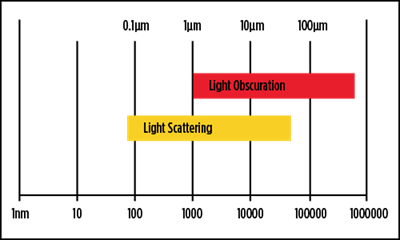Light Obscuration: Optical Method for Particle Detection
Light obscuration or Single Particle Optical Sensing (SPOS), is a high-resolution analysis technique capable of detecting a small percentage of outliers. It can also be used to obtain an overall size distribution, however, sample concentration is an important consideration when using a light obscuration particle counter. The sample must be presented in a dilute form for analysis.
Light obscuration works by passing a dilute stream of particles in a liquid suspension between a light source and a detector. In the HIAC 9703+ liquid particle counter, the light source is a laser diode, which illuminates individual particles in the stream to generate a shadow or blockage of light on the detector. This blockage is called ‘obscuration’. The detector measures the reduction in light intensity and employing a calibration curve, processes the signal to determine particle size.

Widely used across a variety of pharmaceutical applications, light obscuration is recognized by the ISO and USP as the primary method for measuring the size and number of particles in a variety of samples including protein-based formulations and other sterile preparations.
Benefits if Light Obscuration
- Rapid analysis – results in seconds
- Automated process – eliminates operator error
- No additional chemicals/consumables required
- Repeatable and reproducible between instruments
NOTE: HIAC 9703+ liquid particle counter is designed for a variety of pharmaceutical applications and works for both USP <787> and <788> analysis.
Helping researchers and labs maintain compliance with standards
-
Industry Standards
- USP<643>
- 21 CFR Part 11 - Data Integrity
- Maintaining Data Integrity: Understanding FDA ALCOA Guidance
- European Pharmacopoeia EP 2.2.44
- EU GMP Annex 1
- EU GMP Annex 11
- ICH Q2
- ISO 21501
- ISO Regulations
-
IVD-Regulation (IVDR)
- IVDR compliant instruments*
- IVDR compliant software*
- IVDR compliant reagents
- E-book
- Future proofing your flow cytometry panel under IVDR
- In-house IVD FCM panel or not: it depends
- Building IVDR compliant panels for haematological disorders
- Impact of the new EU IVD-Regulation on the daily life of the clinical Flow cytometry laboratory webinar
- Laboratory Developed Test (LDT) vs IVD Validation Workflow
- Meet the Expert — Maurizio Suppo, PhD
- Potential Impacts of EU IVD-Regulation on the Clinical Flow Cytometry Lab
- IVD-R Annex I Global Safety and Performances Requirements (GSPR). A New Set of Requirements for Clinical Laboratories Performing Laboratory Developed Tests
- IVD-R: Key Considerations to Validate a Flow Cytometry Assay According to ISO 15189 Requirements
- Regulatory Entities: Separation with Cooperation
- USP 1046
- USP 1047
- USP <788>, <787> and EP2.9.19
- USP <790>
- ISO 11171 Standard
-
ISO 14644: Airborne Particulate Cleanliness in Cleanrooms and Clean Zones
- Particle Counters Designed to Support ISO 14644-1 and ISO 21501-4 Requirements
- 2015 Published Standards for ISO 14644
- ISO 14644-1 Classification of Air Cleanliness by Particle Concentration
- ISO 21501-4: Light Scattering Airborne Particle Counter for Clean Spaces
- Particle Counting: Terms and Formulas
-
USP <787>
- USP <787>: Particulate Testing Solutions for Contamination Control
- Light Obscuration: Optical Method for Particle Detection
- USP <787>: Subvisible Particulate Matter in Therapeutic Protein Injections
- USP <787>: Application and Scope
- Cleanroom Requirements for Liquid Particle Testing

